Analysis of Residential Tenancies Act in Carol Goodes' Case - Law
VerifiedAdded on 2023/06/04
|8
|2324
|296
Report
AI Summary
This memorandum of advice provides a detailed analysis of the Residential Tenancies Act 1997, focusing on a case involving a tenant named Carol Goodes. The analysis covers key aspects of the Act, including the responsibilities of landlords regarding property maintenance, the tenant's duty to report damage, and the definition of urgent repairs. It examines the implications of mold growth, wood scrapes, and the tenant's dog mess, and their impact on the landlord-tenant relationship. The document also addresses the procedures for reporting complaints, seeking legal action, and potentially terminating the tenancy agreement. Relevant sections of the Act, such as those concerning breach of duty and the tenant's right to pay rent into a special account, are thoroughly discussed. Furthermore, the memorandum references relevant cases decided by the Victorian Civil and Administrative Tribunal (VCAT) and similar tribunals to support the legal arguments and provide precedents for similar situations. The analysis concludes with an assessment of the legal options available to Carol Goodes, providing comprehensive legal advice based on the presented facts and relevant legislation.
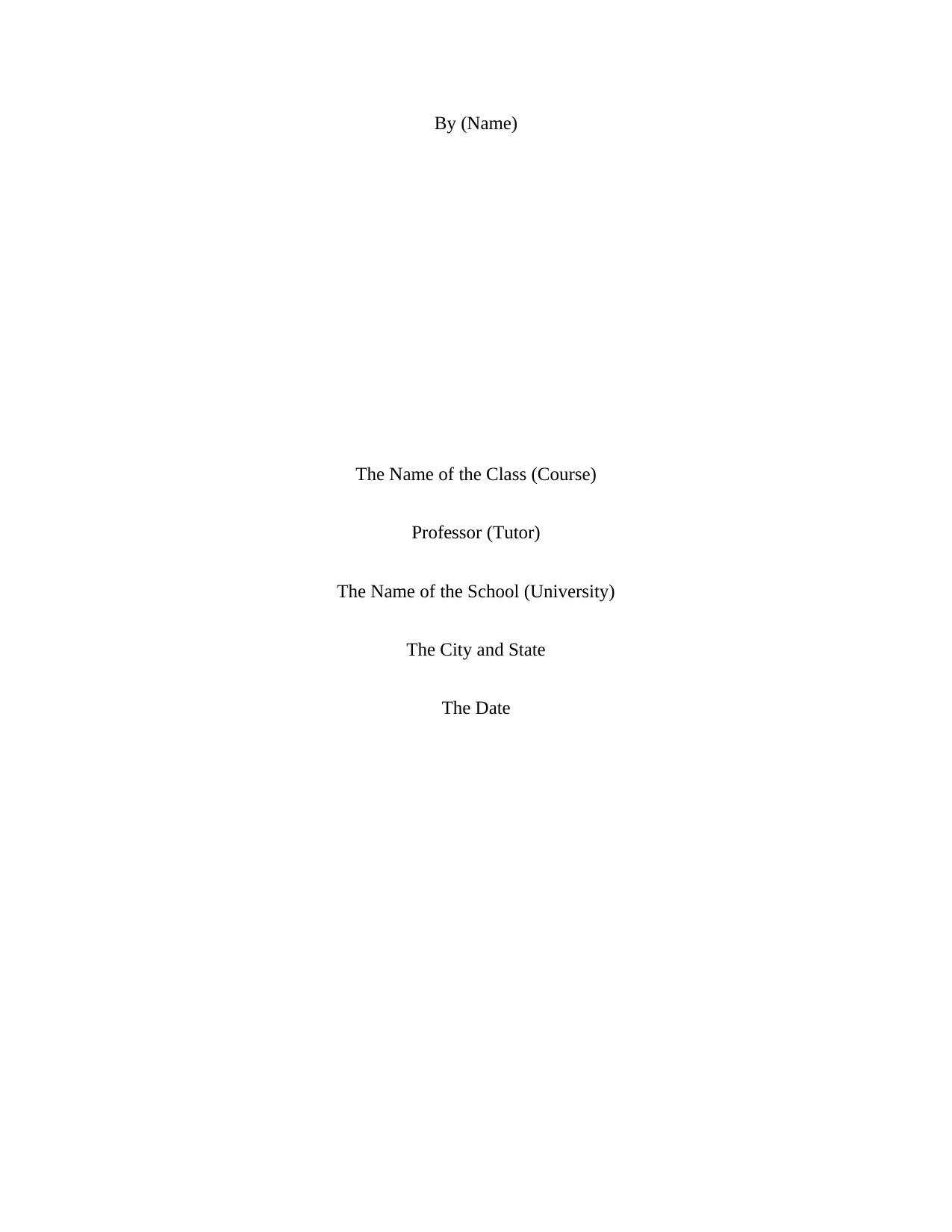
By (Name)
The Name of the Class (Course)
Professor (Tutor)
The Name of the School (University)
The City and State
The Date
The Name of the Class (Course)
Professor (Tutor)
The Name of the School (University)
The City and State
The Date
Paraphrase This Document
Need a fresh take? Get an instant paraphrase of this document with our AI Paraphraser
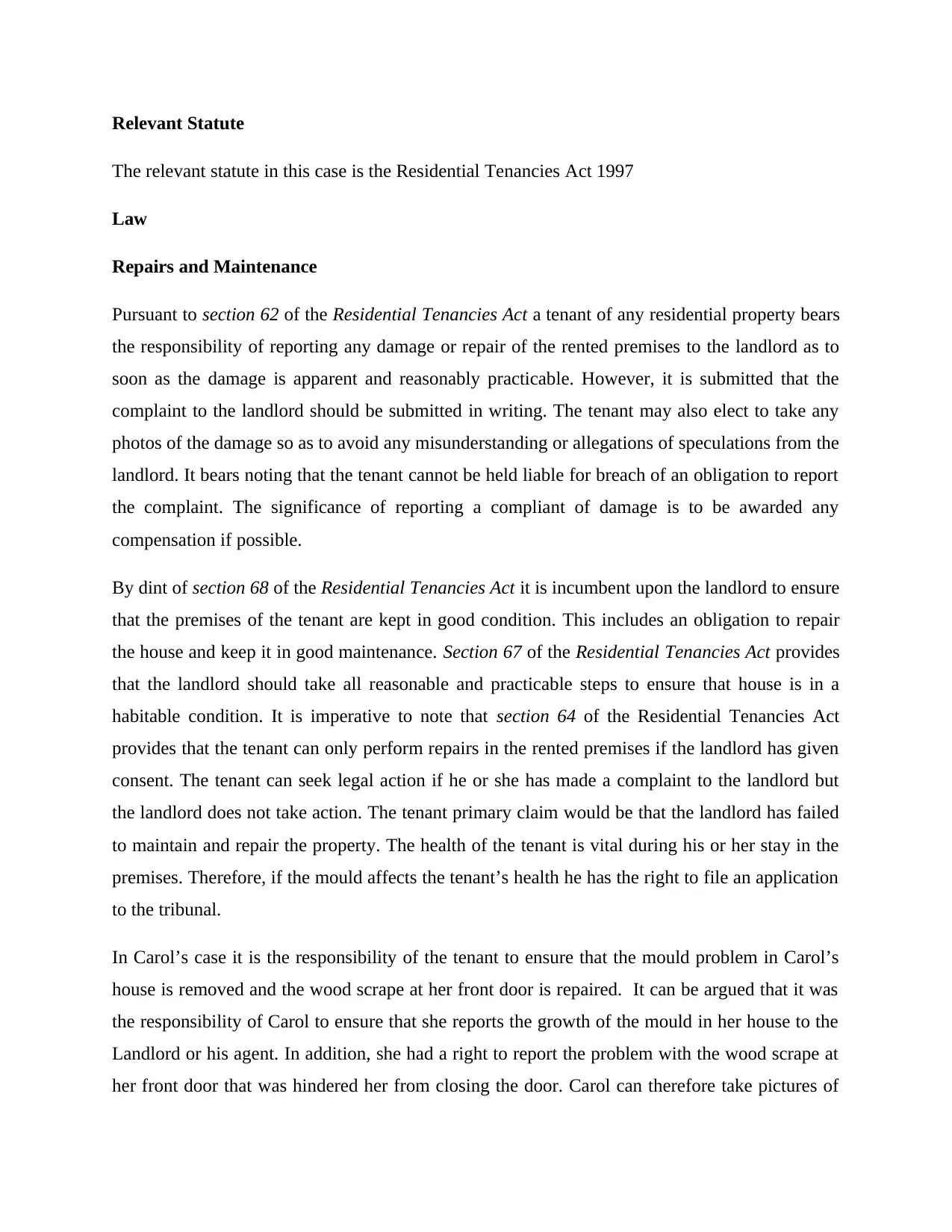
Relevant Statute
The relevant statute in this case is the Residential Tenancies Act 1997
Law
Repairs and Maintenance
Pursuant to section 62 of the Residential Tenancies Act a tenant of any residential property bears
the responsibility of reporting any damage or repair of the rented premises to the landlord as to
soon as the damage is apparent and reasonably practicable. However, it is submitted that the
complaint to the landlord should be submitted in writing. The tenant may also elect to take any
photos of the damage so as to avoid any misunderstanding or allegations of speculations from the
landlord. It bears noting that the tenant cannot be held liable for breach of an obligation to report
the complaint. The significance of reporting a compliant of damage is to be awarded any
compensation if possible.
By dint of section 68 of the Residential Tenancies Act it is incumbent upon the landlord to ensure
that the premises of the tenant are kept in good condition. This includes an obligation to repair
the house and keep it in good maintenance. Section 67 of the Residential Tenancies Act provides
that the landlord should take all reasonable and practicable steps to ensure that house is in a
habitable condition. It is imperative to note that section 64 of the Residential Tenancies Act
provides that the tenant can only perform repairs in the rented premises if the landlord has given
consent. The tenant can seek legal action if he or she has made a complaint to the landlord but
the landlord does not take action. The tenant primary claim would be that the landlord has failed
to maintain and repair the property. The health of the tenant is vital during his or her stay in the
premises. Therefore, if the mould affects the tenant’s health he has the right to file an application
to the tribunal.
In Carol’s case it is the responsibility of the tenant to ensure that the mould problem in Carol’s
house is removed and the wood scrape at her front door is repaired. It can be argued that it was
the responsibility of Carol to ensure that she reports the growth of the mould in her house to the
Landlord or his agent. In addition, she had a right to report the problem with the wood scrape at
her front door that was hindered her from closing the door. Carol can therefore take pictures of
The relevant statute in this case is the Residential Tenancies Act 1997
Law
Repairs and Maintenance
Pursuant to section 62 of the Residential Tenancies Act a tenant of any residential property bears
the responsibility of reporting any damage or repair of the rented premises to the landlord as to
soon as the damage is apparent and reasonably practicable. However, it is submitted that the
complaint to the landlord should be submitted in writing. The tenant may also elect to take any
photos of the damage so as to avoid any misunderstanding or allegations of speculations from the
landlord. It bears noting that the tenant cannot be held liable for breach of an obligation to report
the complaint. The significance of reporting a compliant of damage is to be awarded any
compensation if possible.
By dint of section 68 of the Residential Tenancies Act it is incumbent upon the landlord to ensure
that the premises of the tenant are kept in good condition. This includes an obligation to repair
the house and keep it in good maintenance. Section 67 of the Residential Tenancies Act provides
that the landlord should take all reasonable and practicable steps to ensure that house is in a
habitable condition. It is imperative to note that section 64 of the Residential Tenancies Act
provides that the tenant can only perform repairs in the rented premises if the landlord has given
consent. The tenant can seek legal action if he or she has made a complaint to the landlord but
the landlord does not take action. The tenant primary claim would be that the landlord has failed
to maintain and repair the property. The health of the tenant is vital during his or her stay in the
premises. Therefore, if the mould affects the tenant’s health he has the right to file an application
to the tribunal.
In Carol’s case it is the responsibility of the tenant to ensure that the mould problem in Carol’s
house is removed and the wood scrape at her front door is repaired. It can be argued that it was
the responsibility of Carol to ensure that she reports the growth of the mould in her house to the
Landlord or his agent. In addition, she had a right to report the problem with the wood scrape at
her front door that was hindered her from closing the door. Carol can therefore take pictures of
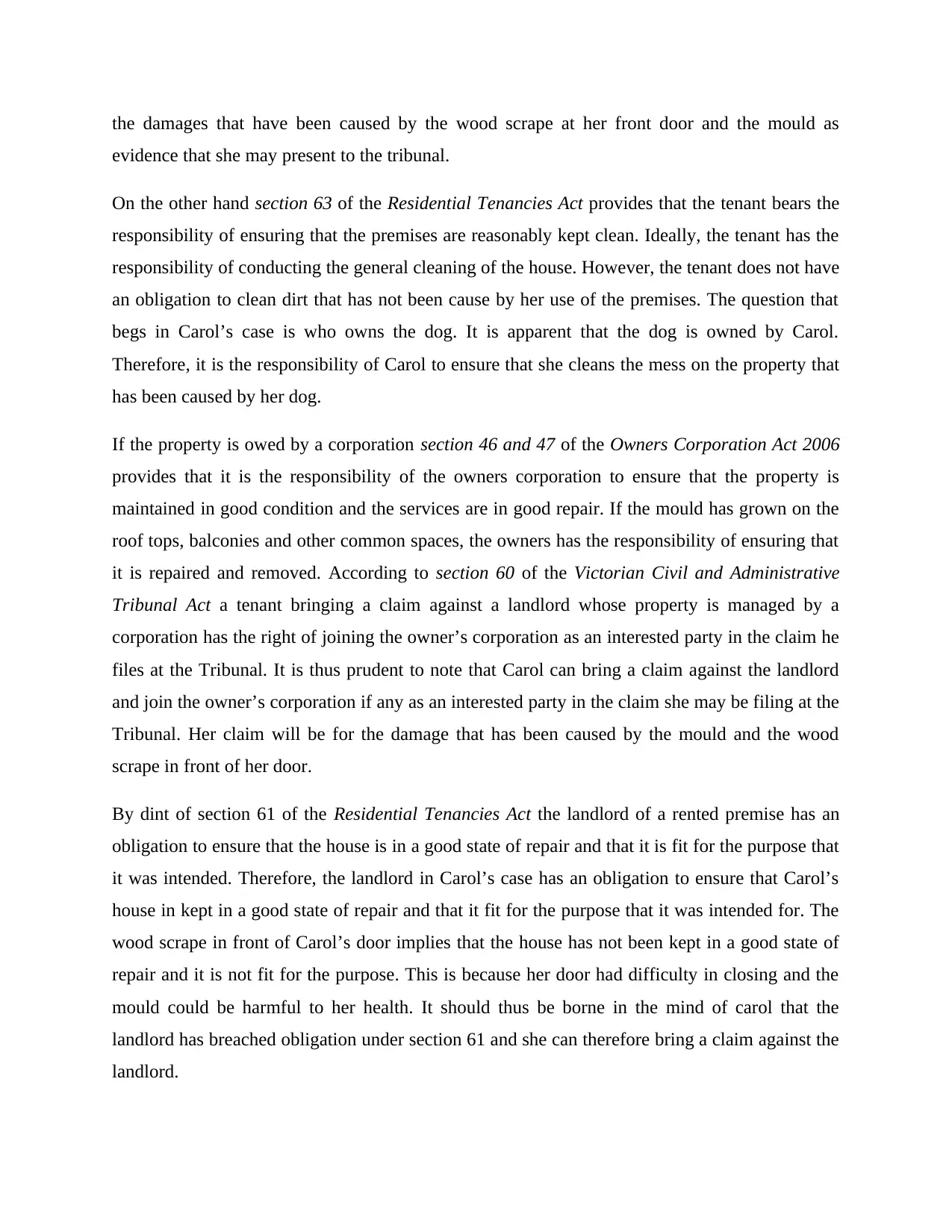
the damages that have been caused by the wood scrape at her front door and the mould as
evidence that she may present to the tribunal.
On the other hand section 63 of the Residential Tenancies Act provides that the tenant bears the
responsibility of ensuring that the premises are reasonably kept clean. Ideally, the tenant has the
responsibility of conducting the general cleaning of the house. However, the tenant does not have
an obligation to clean dirt that has not been cause by her use of the premises. The question that
begs in Carol’s case is who owns the dog. It is apparent that the dog is owned by Carol.
Therefore, it is the responsibility of Carol to ensure that she cleans the mess on the property that
has been caused by her dog.
If the property is owed by a corporation section 46 and 47 of the Owners Corporation Act 2006
provides that it is the responsibility of the owners corporation to ensure that the property is
maintained in good condition and the services are in good repair. If the mould has grown on the
roof tops, balconies and other common spaces, the owners has the responsibility of ensuring that
it is repaired and removed. According to section 60 of the Victorian Civil and Administrative
Tribunal Act a tenant bringing a claim against a landlord whose property is managed by a
corporation has the right of joining the owner’s corporation as an interested party in the claim he
files at the Tribunal. It is thus prudent to note that Carol can bring a claim against the landlord
and join the owner’s corporation if any as an interested party in the claim she may be filing at the
Tribunal. Her claim will be for the damage that has been caused by the mould and the wood
scrape in front of her door.
By dint of section 61 of the Residential Tenancies Act the landlord of a rented premise has an
obligation to ensure that the house is in a good state of repair and that it is fit for the purpose that
it was intended. Therefore, the landlord in Carol’s case has an obligation to ensure that Carol’s
house in kept in a good state of repair and that it fit for the purpose that it was intended for. The
wood scrape in front of Carol’s door implies that the house has not been kept in a good state of
repair and it is not fit for the purpose. This is because her door had difficulty in closing and the
mould could be harmful to her health. It should thus be borne in the mind of carol that the
landlord has breached obligation under section 61 and she can therefore bring a claim against the
landlord.
evidence that she may present to the tribunal.
On the other hand section 63 of the Residential Tenancies Act provides that the tenant bears the
responsibility of ensuring that the premises are reasonably kept clean. Ideally, the tenant has the
responsibility of conducting the general cleaning of the house. However, the tenant does not have
an obligation to clean dirt that has not been cause by her use of the premises. The question that
begs in Carol’s case is who owns the dog. It is apparent that the dog is owned by Carol.
Therefore, it is the responsibility of Carol to ensure that she cleans the mess on the property that
has been caused by her dog.
If the property is owed by a corporation section 46 and 47 of the Owners Corporation Act 2006
provides that it is the responsibility of the owners corporation to ensure that the property is
maintained in good condition and the services are in good repair. If the mould has grown on the
roof tops, balconies and other common spaces, the owners has the responsibility of ensuring that
it is repaired and removed. According to section 60 of the Victorian Civil and Administrative
Tribunal Act a tenant bringing a claim against a landlord whose property is managed by a
corporation has the right of joining the owner’s corporation as an interested party in the claim he
files at the Tribunal. It is thus prudent to note that Carol can bring a claim against the landlord
and join the owner’s corporation if any as an interested party in the claim she may be filing at the
Tribunal. Her claim will be for the damage that has been caused by the mould and the wood
scrape in front of her door.
By dint of section 61 of the Residential Tenancies Act the landlord of a rented premise has an
obligation to ensure that the house is in a good state of repair and that it is fit for the purpose that
it was intended. Therefore, the landlord in Carol’s case has an obligation to ensure that Carol’s
house in kept in a good state of repair and that it fit for the purpose that it was intended for. The
wood scrape in front of Carol’s door implies that the house has not been kept in a good state of
repair and it is not fit for the purpose. This is because her door had difficulty in closing and the
mould could be harmful to her health. It should thus be borne in the mind of carol that the
landlord has breached obligation under section 61 and she can therefore bring a claim against the
landlord.
⊘ This is a preview!⊘
Do you want full access?
Subscribe today to unlock all pages.

Trusted by 1+ million students worldwide
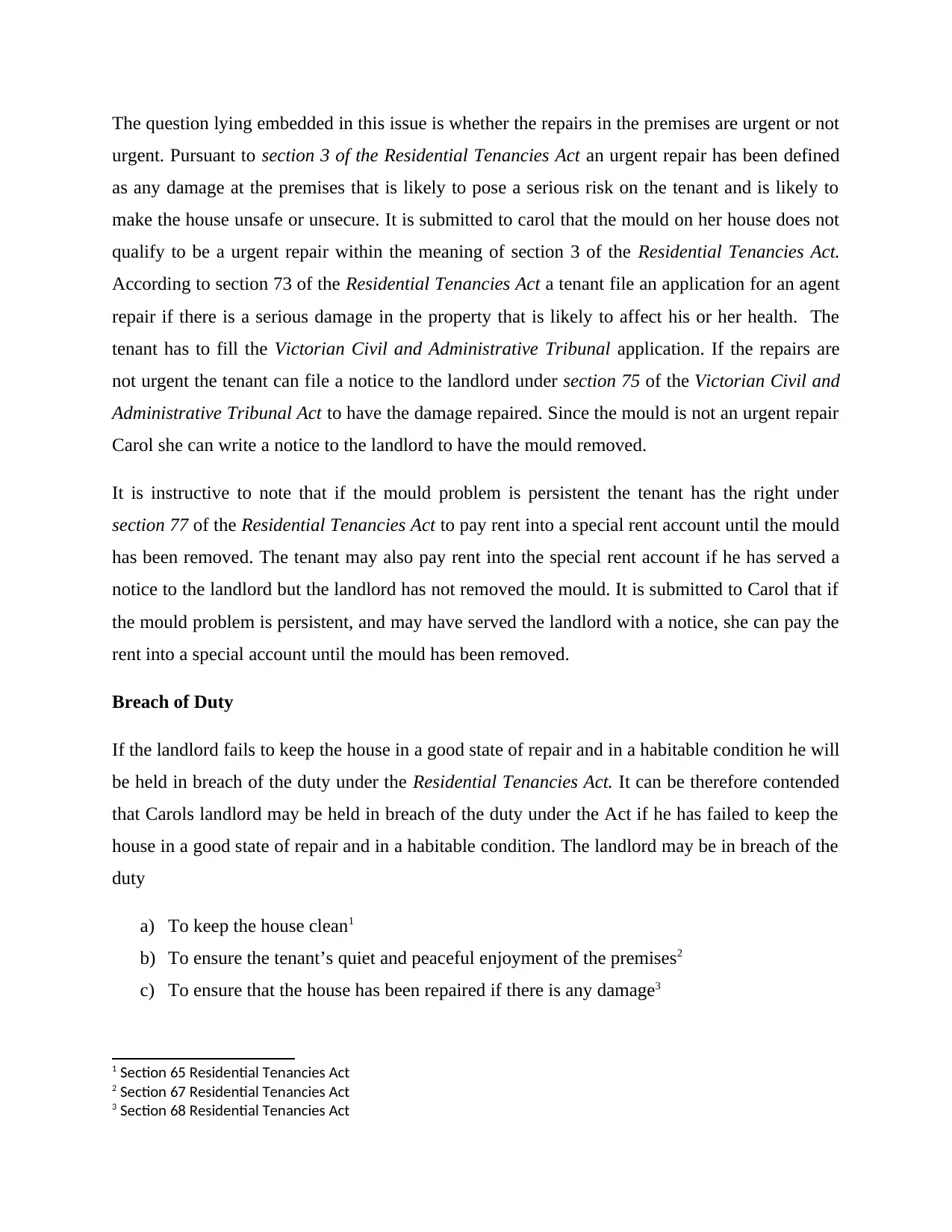
The question lying embedded in this issue is whether the repairs in the premises are urgent or not
urgent. Pursuant to section 3 of the Residential Tenancies Act an urgent repair has been defined
as any damage at the premises that is likely to pose a serious risk on the tenant and is likely to
make the house unsafe or unsecure. It is submitted to carol that the mould on her house does not
qualify to be a urgent repair within the meaning of section 3 of the Residential Tenancies Act.
According to section 73 of the Residential Tenancies Act a tenant file an application for an agent
repair if there is a serious damage in the property that is likely to affect his or her health. The
tenant has to fill the Victorian Civil and Administrative Tribunal application. If the repairs are
not urgent the tenant can file a notice to the landlord under section 75 of the Victorian Civil and
Administrative Tribunal Act to have the damage repaired. Since the mould is not an urgent repair
Carol she can write a notice to the landlord to have the mould removed.
It is instructive to note that if the mould problem is persistent the tenant has the right under
section 77 of the Residential Tenancies Act to pay rent into a special rent account until the mould
has been removed. The tenant may also pay rent into the special rent account if he has served a
notice to the landlord but the landlord has not removed the mould. It is submitted to Carol that if
the mould problem is persistent, and may have served the landlord with a notice, she can pay the
rent into a special account until the mould has been removed.
Breach of Duty
If the landlord fails to keep the house in a good state of repair and in a habitable condition he will
be held in breach of the duty under the Residential Tenancies Act. It can be therefore contended
that Carols landlord may be held in breach of the duty under the Act if he has failed to keep the
house in a good state of repair and in a habitable condition. The landlord may be in breach of the
duty
a) To keep the house clean1
b) To ensure the tenant’s quiet and peaceful enjoyment of the premises2
c) To ensure that the house has been repaired if there is any damage3
1 Section 65 Residential Tenancies Act
2 Section 67 Residential Tenancies Act
3 Section 68 Residential Tenancies Act
urgent. Pursuant to section 3 of the Residential Tenancies Act an urgent repair has been defined
as any damage at the premises that is likely to pose a serious risk on the tenant and is likely to
make the house unsafe or unsecure. It is submitted to carol that the mould on her house does not
qualify to be a urgent repair within the meaning of section 3 of the Residential Tenancies Act.
According to section 73 of the Residential Tenancies Act a tenant file an application for an agent
repair if there is a serious damage in the property that is likely to affect his or her health. The
tenant has to fill the Victorian Civil and Administrative Tribunal application. If the repairs are
not urgent the tenant can file a notice to the landlord under section 75 of the Victorian Civil and
Administrative Tribunal Act to have the damage repaired. Since the mould is not an urgent repair
Carol she can write a notice to the landlord to have the mould removed.
It is instructive to note that if the mould problem is persistent the tenant has the right under
section 77 of the Residential Tenancies Act to pay rent into a special rent account until the mould
has been removed. The tenant may also pay rent into the special rent account if he has served a
notice to the landlord but the landlord has not removed the mould. It is submitted to Carol that if
the mould problem is persistent, and may have served the landlord with a notice, she can pay the
rent into a special account until the mould has been removed.
Breach of Duty
If the landlord fails to keep the house in a good state of repair and in a habitable condition he will
be held in breach of the duty under the Residential Tenancies Act. It can be therefore contended
that Carols landlord may be held in breach of the duty under the Act if he has failed to keep the
house in a good state of repair and in a habitable condition. The landlord may be in breach of the
duty
a) To keep the house clean1
b) To ensure the tenant’s quiet and peaceful enjoyment of the premises2
c) To ensure that the house has been repaired if there is any damage3
1 Section 65 Residential Tenancies Act
2 Section 67 Residential Tenancies Act
3 Section 68 Residential Tenancies Act
Paraphrase This Document
Need a fresh take? Get an instant paraphrase of this document with our AI Paraphraser
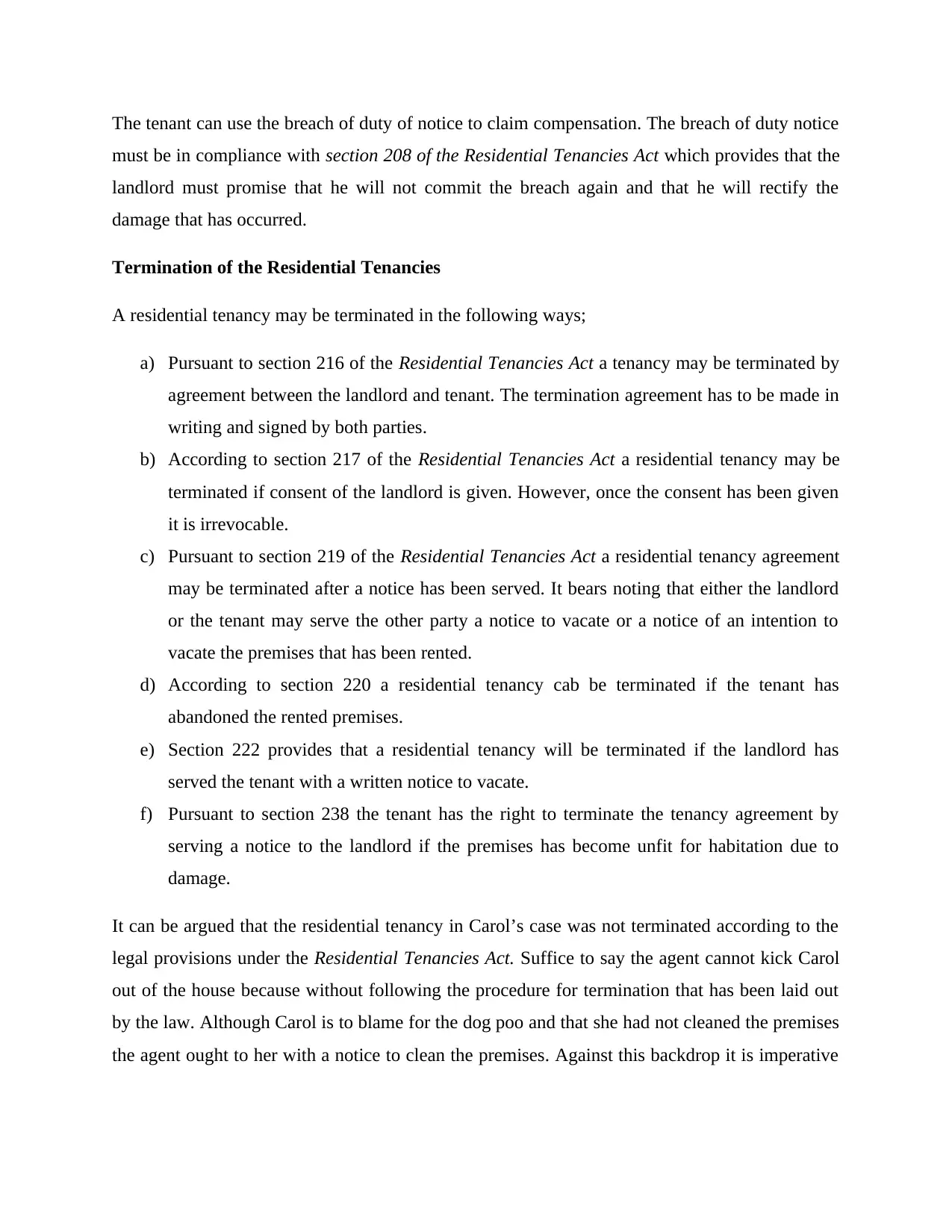
The tenant can use the breach of duty of notice to claim compensation. The breach of duty notice
must be in compliance with section 208 of the Residential Tenancies Act which provides that the
landlord must promise that he will not commit the breach again and that he will rectify the
damage that has occurred.
Termination of the Residential Tenancies
A residential tenancy may be terminated in the following ways;
a) Pursuant to section 216 of the Residential Tenancies Act a tenancy may be terminated by
agreement between the landlord and tenant. The termination agreement has to be made in
writing and signed by both parties.
b) According to section 217 of the Residential Tenancies Act a residential tenancy may be
terminated if consent of the landlord is given. However, once the consent has been given
it is irrevocable.
c) Pursuant to section 219 of the Residential Tenancies Act a residential tenancy agreement
may be terminated after a notice has been served. It bears noting that either the landlord
or the tenant may serve the other party a notice to vacate or a notice of an intention to
vacate the premises that has been rented.
d) According to section 220 a residential tenancy cab be terminated if the tenant has
abandoned the rented premises.
e) Section 222 provides that a residential tenancy will be terminated if the landlord has
served the tenant with a written notice to vacate.
f) Pursuant to section 238 the tenant has the right to terminate the tenancy agreement by
serving a notice to the landlord if the premises has become unfit for habitation due to
damage.
It can be argued that the residential tenancy in Carol’s case was not terminated according to the
legal provisions under the Residential Tenancies Act. Suffice to say the agent cannot kick Carol
out of the house because without following the procedure for termination that has been laid out
by the law. Although Carol is to blame for the dog poo and that she had not cleaned the premises
the agent ought to her with a notice to clean the premises. Against this backdrop it is imperative
must be in compliance with section 208 of the Residential Tenancies Act which provides that the
landlord must promise that he will not commit the breach again and that he will rectify the
damage that has occurred.
Termination of the Residential Tenancies
A residential tenancy may be terminated in the following ways;
a) Pursuant to section 216 of the Residential Tenancies Act a tenancy may be terminated by
agreement between the landlord and tenant. The termination agreement has to be made in
writing and signed by both parties.
b) According to section 217 of the Residential Tenancies Act a residential tenancy may be
terminated if consent of the landlord is given. However, once the consent has been given
it is irrevocable.
c) Pursuant to section 219 of the Residential Tenancies Act a residential tenancy agreement
may be terminated after a notice has been served. It bears noting that either the landlord
or the tenant may serve the other party a notice to vacate or a notice of an intention to
vacate the premises that has been rented.
d) According to section 220 a residential tenancy cab be terminated if the tenant has
abandoned the rented premises.
e) Section 222 provides that a residential tenancy will be terminated if the landlord has
served the tenant with a written notice to vacate.
f) Pursuant to section 238 the tenant has the right to terminate the tenancy agreement by
serving a notice to the landlord if the premises has become unfit for habitation due to
damage.
It can be argued that the residential tenancy in Carol’s case was not terminated according to the
legal provisions under the Residential Tenancies Act. Suffice to say the agent cannot kick Carol
out of the house because without following the procedure for termination that has been laid out
by the law. Although Carol is to blame for the dog poo and that she had not cleaned the premises
the agent ought to her with a notice to clean the premises. Against this backdrop it is imperative
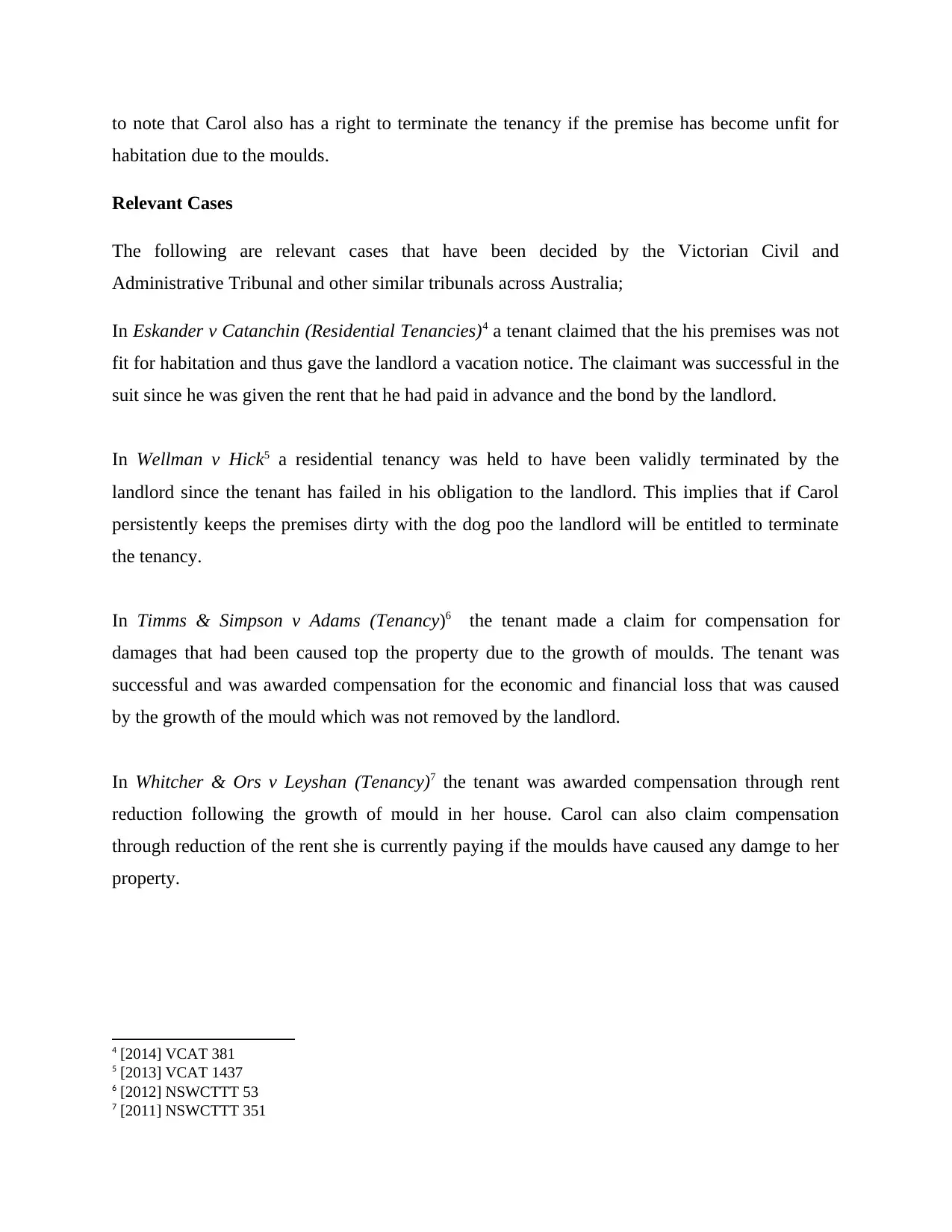
to note that Carol also has a right to terminate the tenancy if the premise has become unfit for
habitation due to the moulds.
Relevant Cases
The following are relevant cases that have been decided by the Victorian Civil and
Administrative Tribunal and other similar tribunals across Australia;
In Eskander v Catanchin (Residential Tenancies)4 a tenant claimed that the his premises was not
fit for habitation and thus gave the landlord a vacation notice. The claimant was successful in the
suit since he was given the rent that he had paid in advance and the bond by the landlord.
In Wellman v Hick5 a residential tenancy was held to have been validly terminated by the
landlord since the tenant has failed in his obligation to the landlord. This implies that if Carol
persistently keeps the premises dirty with the dog poo the landlord will be entitled to terminate
the tenancy.
In Timms & Simpson v Adams (Tenancy)6 the tenant made a claim for compensation for
damages that had been caused top the property due to the growth of moulds. The tenant was
successful and was awarded compensation for the economic and financial loss that was caused
by the growth of the mould which was not removed by the landlord.
In Whitcher & Ors v Leyshan (Tenancy)7 the tenant was awarded compensation through rent
reduction following the growth of mould in her house. Carol can also claim compensation
through reduction of the rent she is currently paying if the moulds have caused any damge to her
property.
4 [2014] VCAT 381
5 [2013] VCAT 1437
6 [2012] NSWCTTT 53
7 [2011] NSWCTTT 351
habitation due to the moulds.
Relevant Cases
The following are relevant cases that have been decided by the Victorian Civil and
Administrative Tribunal and other similar tribunals across Australia;
In Eskander v Catanchin (Residential Tenancies)4 a tenant claimed that the his premises was not
fit for habitation and thus gave the landlord a vacation notice. The claimant was successful in the
suit since he was given the rent that he had paid in advance and the bond by the landlord.
In Wellman v Hick5 a residential tenancy was held to have been validly terminated by the
landlord since the tenant has failed in his obligation to the landlord. This implies that if Carol
persistently keeps the premises dirty with the dog poo the landlord will be entitled to terminate
the tenancy.
In Timms & Simpson v Adams (Tenancy)6 the tenant made a claim for compensation for
damages that had been caused top the property due to the growth of moulds. The tenant was
successful and was awarded compensation for the economic and financial loss that was caused
by the growth of the mould which was not removed by the landlord.
In Whitcher & Ors v Leyshan (Tenancy)7 the tenant was awarded compensation through rent
reduction following the growth of mould in her house. Carol can also claim compensation
through reduction of the rent she is currently paying if the moulds have caused any damge to her
property.
4 [2014] VCAT 381
5 [2013] VCAT 1437
6 [2012] NSWCTTT 53
7 [2011] NSWCTTT 351
⊘ This is a preview!⊘
Do you want full access?
Subscribe today to unlock all pages.

Trusted by 1+ million students worldwide
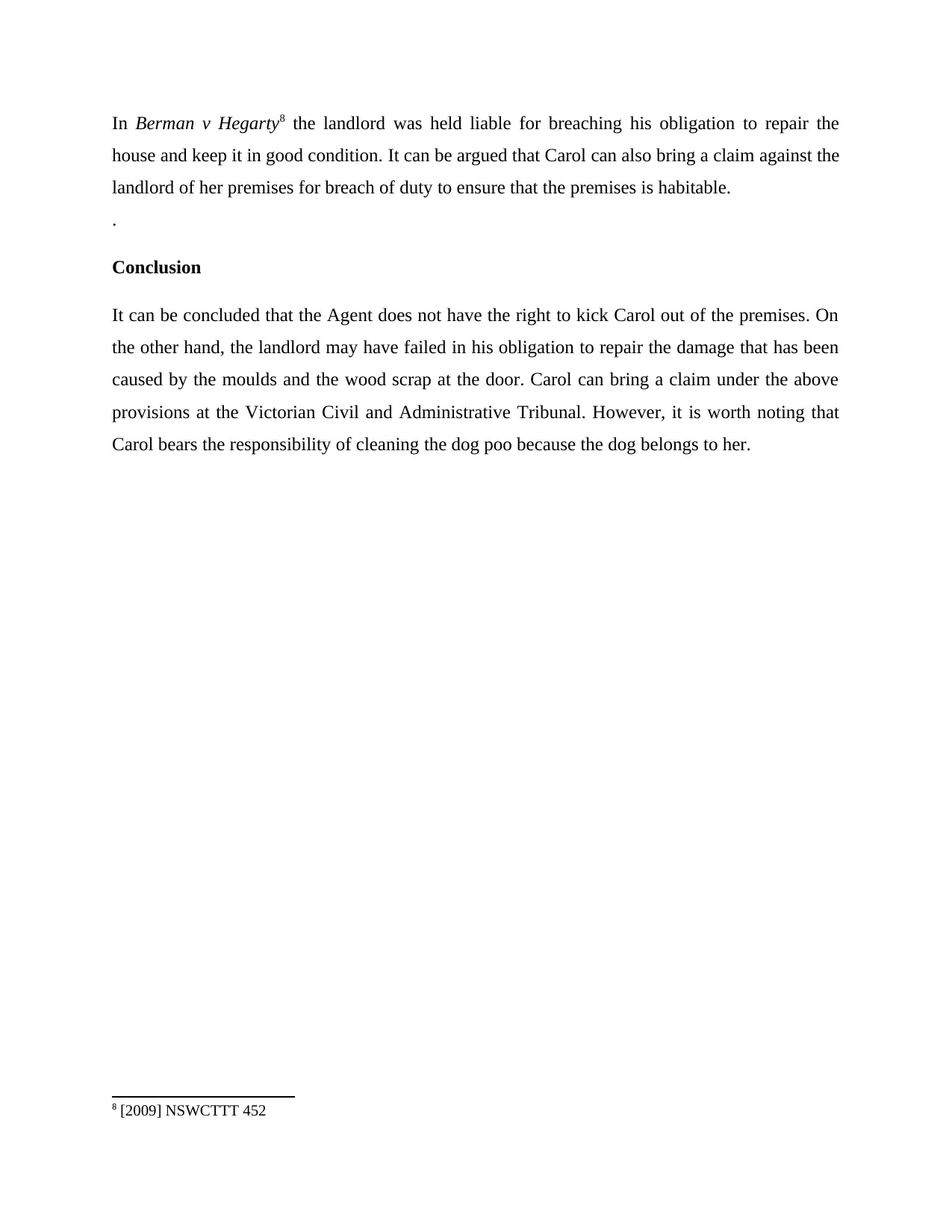
In Berman v Hegarty8 the landlord was held liable for breaching his obligation to repair the
house and keep it in good condition. It can be argued that Carol can also bring a claim against the
landlord of her premises for breach of duty to ensure that the premises is habitable.
.
Conclusion
It can be concluded that the Agent does not have the right to kick Carol out of the premises. On
the other hand, the landlord may have failed in his obligation to repair the damage that has been
caused by the moulds and the wood scrap at the door. Carol can bring a claim under the above
provisions at the Victorian Civil and Administrative Tribunal. However, it is worth noting that
Carol bears the responsibility of cleaning the dog poo because the dog belongs to her.
8 [2009] NSWCTTT 452
house and keep it in good condition. It can be argued that Carol can also bring a claim against the
landlord of her premises for breach of duty to ensure that the premises is habitable.
.
Conclusion
It can be concluded that the Agent does not have the right to kick Carol out of the premises. On
the other hand, the landlord may have failed in his obligation to repair the damage that has been
caused by the moulds and the wood scrap at the door. Carol can bring a claim under the above
provisions at the Victorian Civil and Administrative Tribunal. However, it is worth noting that
Carol bears the responsibility of cleaning the dog poo because the dog belongs to her.
8 [2009] NSWCTTT 452
Paraphrase This Document
Need a fresh take? Get an instant paraphrase of this document with our AI Paraphraser
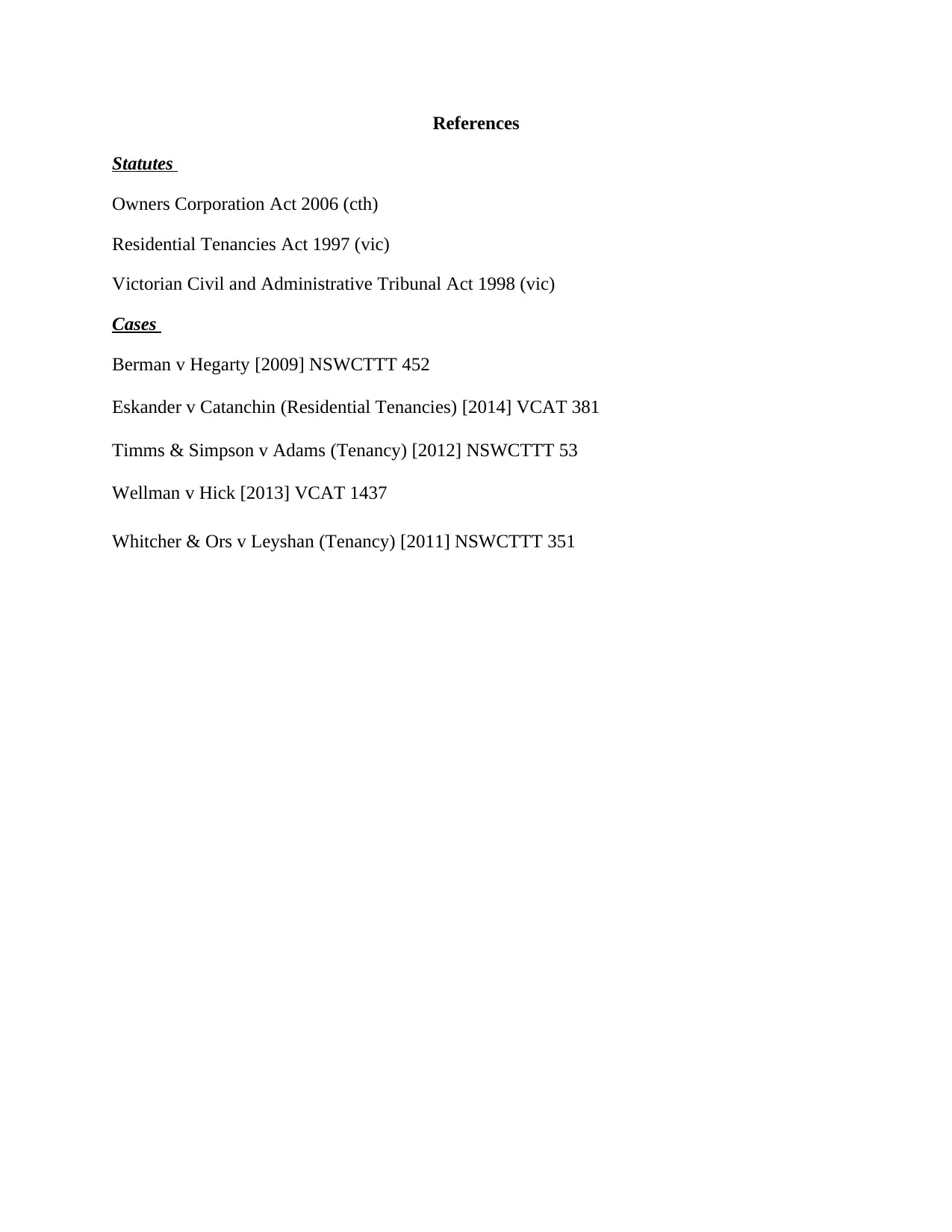
References
Statutes
Owners Corporation Act 2006 (cth)
Residential Tenancies Act 1997 (vic)
Victorian Civil and Administrative Tribunal Act 1998 (vic)
Cases
Berman v Hegarty [2009] NSWCTTT 452
Eskander v Catanchin (Residential Tenancies) [2014] VCAT 381
Timms & Simpson v Adams (Tenancy) [2012] NSWCTTT 53
Wellman v Hick [2013] VCAT 1437
Whitcher & Ors v Leyshan (Tenancy) [2011] NSWCTTT 351
Statutes
Owners Corporation Act 2006 (cth)
Residential Tenancies Act 1997 (vic)
Victorian Civil and Administrative Tribunal Act 1998 (vic)
Cases
Berman v Hegarty [2009] NSWCTTT 452
Eskander v Catanchin (Residential Tenancies) [2014] VCAT 381
Timms & Simpson v Adams (Tenancy) [2012] NSWCTTT 53
Wellman v Hick [2013] VCAT 1437
Whitcher & Ors v Leyshan (Tenancy) [2011] NSWCTTT 351
1 out of 8
Related Documents
Your All-in-One AI-Powered Toolkit for Academic Success.
+13062052269
info@desklib.com
Available 24*7 on WhatsApp / Email
![[object Object]](/_next/static/media/star-bottom.7253800d.svg)
Unlock your academic potential
Copyright © 2020–2025 A2Z Services. All Rights Reserved. Developed and managed by ZUCOL.


